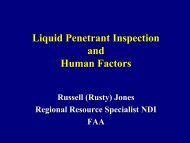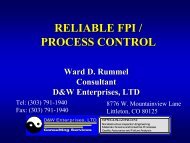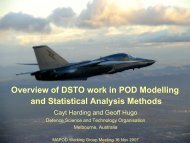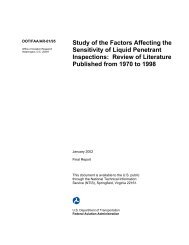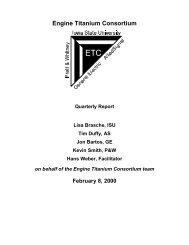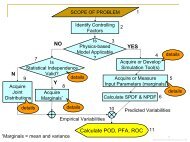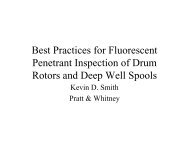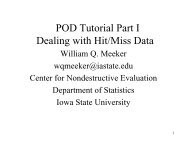Engine Titanium Consortium - Center for Nondestructive Evaluation ...
Engine Titanium Consortium - Center for Nondestructive Evaluation ...
Engine Titanium Consortium - Center for Nondestructive Evaluation ...
You also want an ePaper? Increase the reach of your titles
YUMPU automatically turns print PDFs into web optimized ePapers that Google loves.
size was adequate to support a 0.045” maximal beam diameter. Eight such zones are needed to<br />
cover 3.2” of material and nine zones would cover almost 4”. If the water path were fixed such an<br />
inspection would require nine different transducers. We determined that by varying the water path<br />
one transducer could be used to inspect three zones. Thus, <strong>for</strong> nine zones, three transducers are<br />
required. The parameters of these three probes are listed in Table 1. These are the transducers<br />
originally designed <strong>for</strong> zones 2, 5 and 8 <strong>for</strong> the original inspection scheme that used a fixed 3” water<br />
path. For example, the zone 2 transducer (transducer #1 in Table 1) can also inspect zones 1 and 3<br />
with 4.8” and 1.2” water paths respectively. The final inspection scheme that utilizes three<br />
transducers is presented in Table 2. For this scheme, the on-axis profile (of pressured squared) is<br />
shown in Figure 7. The amplitude of an echo from a small defect is approximately proportional to<br />
pressure squared, so Figure 7 displays the manner in which defect signal amplitude depends on<br />
depth when the proposed scheme is used without a DAC.<br />
On-axis profile <strong>for</strong> 3-transducer 7/16" zone design<br />
Ammplitude<br />
8E-04<br />
7E-04<br />
6E-04<br />
5E-04<br />
4E-04<br />
3E-04<br />
2E-04<br />
1E-04<br />
Zone1<br />
Zone2<br />
Zone3<br />
Zone4<br />
Zone5<br />
Zone6<br />
Zone7<br />
Zone8<br />
Zone9<br />
0E+00<br />
0.0 0.5 1.0 1.5 2.0 2.5 3.0 3.5 4.0<br />
Depth, in<br />
Figure 7. Predicted on-axis, pressure-squared, beam profile <strong>for</strong> each zone using the 3-transducer<br />
7/16” zone inspection scheme.<br />
The designed optimal transducers have diameters that are not exactly multiples of 1”. However, by<br />
slightly varying the water paths, we believe the inspection can be per<strong>for</strong>med by three F6<br />
transducers with diameters of 1”, 2” and 3”. The 1” diameter F6 transducer is already available,<br />
and the 2” diameter transducer has been ordered. The intent is to test the proposed inspection <strong>for</strong><br />
the first 6 zones during the next quarter. Based on those results the decision will be made on how<br />
to proceed. The use of a DAC to produce a uni<strong>for</strong>m amplitude <strong>for</strong> #1/2 FBHs throughout a zone will<br />
also be investigated in the upcoming quarter.<br />
Quarterly Report – January 1, 2002 –March 31, 2002<br />
print date/time: 6/6/2002 - 8:39 AM – Page 64



